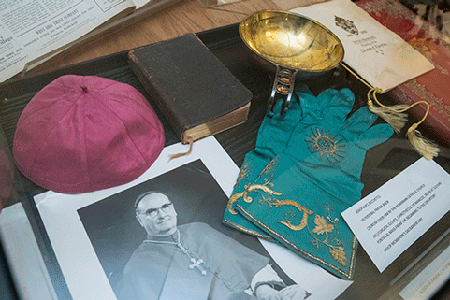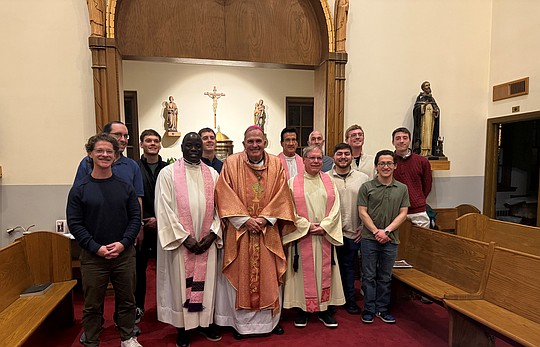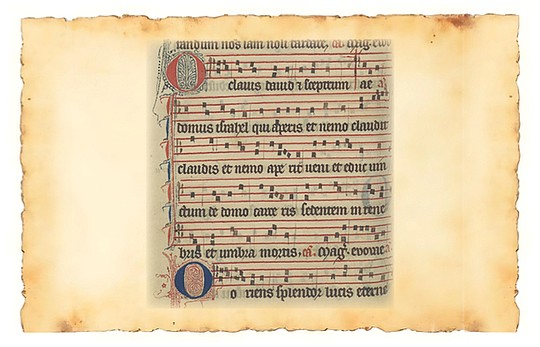Exhibit documents story of the Diocese of Trenton
July 29, 2019 at 12:37 p.m.

By Mary Morrell | Correspondent
Pope Francis’ description of the Church as “a pilgrim in time” was brought to life for the Church in New Jersey during a recent exhibit in the Aquinas Institute, Princeton.
Photo Gallery: Aquinas Institute hosts exhibit on Trenton Diocese
Visitors to the exhibit, titled “The Diocese of Trenton: This is Our Story,” viewed vignettes spanning centuries that brought forth the Diocese and unfolded historical memories of its growth and the work of the faithful.
The exhibit, which ran from Nov. 10 to Dec. 7, was curated by Father Gabriel Zeis, member of the third order regular of St. Francis, chaplain in the Institute and diocesan vicar for Catholic education. It was the third in a series of exhibits, following “The Printed Word: Faith Aspirations of a Young Nation” in 2106, and “Laudato Si: Proclaiming God’s Glory in Nature” in 2017.
The history of the Diocese of Trenton, outlined by the exhibit, begins well before its formal establishment in 1881. To understand how it came to be, one must go back more than 200 years to a time when only a few brave Catholics ventured across the ocean to settle in the new colonies of America.
Among the artifacts of the exhibit were mementos of these pilgrims, including a medallion from the early 1700s bearing the image of Our Lady of Loretto, which was often worn by early Catholics during their travels, and plague bundles to ward off illness while on board ship and venturing through the wilderness.
Letters, articles and other documents on display marked the beginnings of Catholicism in what was known as West Jersey and East Jersey, and confirmed the challenges for Catholics settling in New Jersey during a time of anti-Catholicism and discriminatory laws.
Among those settlers was John Tathum, one of the first Catholics in New Jersey, and a man who was believed, by some, to be the first Catholic to perform the duties of governor of West Jersey in 1690, though Catholics were prevented by constitutional law from holding office in the state until 1845.
Among the artifacts was a Commentary of the Scripture of St. Jerome, believed to have been part of Tathum’s vast Catholic library, where visiting Jesuits would often come to study.
Remnants of the missionary work of the Jesuits among the Lenni Lenape native population were also on display, including items bearing the name of Jesus, the sign of the Jesuits, brought by these missionaries and given to the Native Americans.
Old photos, Bibles, newspaper clippings and artifacts of glass, ceramics and iron implements helped tell the story of a people determined to work hard, establish homes, raise families and live their faith in a new country – people like the German immigrants who labored for the Quakers in their industries of glassmaking, iron works and printing.
Visitors to the exhibit viewed the wall of portraits of the Diocese’s bishops, beginning with Bishop Michael J. O’Farrell, named in 1881, and myriad artifacts that documented the work done during their shepherding of the Diocese for 138 years.
Eye-Opening Visit
Like many parishioners, Sue Keiss moved into the Trenton Diocese as an adult and knew little about its history. Keiss, a member of Our Lady Queen of Peace Parish, Hainesport, described the exhibit as an eye-opening experience.
“The whole display was so encompassing and so very well-done,” said Keiss, who found the display of artifacts, photos, news clips and reminiscences related to St. Mary of the Assumption Cathedral, Trenton, very compelling.
She had been unaware of the history of the Cathedral, including the massive and fatal fire that consumed “old St. Mary’s” on March 14, 1956, and its resurrection as “new Saint Mary Cathedral” three years later to the day.
A self-described architecture enthusiast, Keiss said she was amazed to learn “how quickly the new Cathedral was raised and put back into service” as the Mother Church of the Diocese and the source of spiritual life for its faithful.
The focus on the Cathedral was but one highlight of the wide-ranging exhibition, said Keiss, who attended with her friend Ida Nagy, a member of St. Joan of Arc Parish, Marlton. There were spectacular pieces, such as the remarkable Bonaparte Chalice commissioned by Napoleon’s brother, Joseph, who resided in New Jersey after his brother’s fall.
But equally eye-catching were items that reflected the Catholic faith through the handiwork of its parishioners. Keiss and Nagy said they were especially moved by a large quilt composed of squares worked by faithful in each parish. “It would be nice if it could travel through the diocesan schools,” Keiss said. “It would give the kids an understanding of all the parishes that are part of the Diocese.”
Nagy, who had a business in historical documents with her late husband, John, said she appreciated that, in arranging the exhibition, Father Zeis showed a progression of the episcopacy in the Trenton Diocese through use of original documents. “Father Zeis’ thoughtful presentation of these rare pieces of paper was excellent, as was his commentary on their subject matter,” said Nagy.
Generous Contributions
The quilt was donated to the exhibit by Rosemarie “Chick” McGinty, who was included among the dedicated and inspirational members of the exhibit’s “Living Stones” section. McGinty was noted as the first diocesan director of religious education, at the request of Bishop George W. Ahr. McGinty explained that the quilt was made by parish religious educators, with each square representing a parish community.
Items on display were gathered from a variety of sources, explained Father Zeis, including parish, diocesan, museum and university archives, in addition to numerous artifacts from private collectors, all generously provided on loan to the exhibit.
Richard Hunter, president and principal archaeologist of Hunter Research, Trenton, was principally responsible for those artifacts related to John Baptist Satori, considered by historians as the father of the Diocese of Trenton.
Father Zeis hoped visitors to the exhibit would “remember the meaningful past of their Catholic community, and the holy and great people who struggled to live their faith,” and would encourage them to commit “to their own spiritual growth so that they, too, may plant strong seeds of faith for the future.”
Lois Rogers contributed to this story.
[[In-content Ad]]
Related Stories
Monday, December 15, 2025
E-Editions
Events
By Mary Morrell | Correspondent
Pope Francis’ description of the Church as “a pilgrim in time” was brought to life for the Church in New Jersey during a recent exhibit in the Aquinas Institute, Princeton.
Photo Gallery: Aquinas Institute hosts exhibit on Trenton Diocese
Visitors to the exhibit, titled “The Diocese of Trenton: This is Our Story,” viewed vignettes spanning centuries that brought forth the Diocese and unfolded historical memories of its growth and the work of the faithful.
The exhibit, which ran from Nov. 10 to Dec. 7, was curated by Father Gabriel Zeis, member of the third order regular of St. Francis, chaplain in the Institute and diocesan vicar for Catholic education. It was the third in a series of exhibits, following “The Printed Word: Faith Aspirations of a Young Nation” in 2106, and “Laudato Si: Proclaiming God’s Glory in Nature” in 2017.
The history of the Diocese of Trenton, outlined by the exhibit, begins well before its formal establishment in 1881. To understand how it came to be, one must go back more than 200 years to a time when only a few brave Catholics ventured across the ocean to settle in the new colonies of America.
Among the artifacts of the exhibit were mementos of these pilgrims, including a medallion from the early 1700s bearing the image of Our Lady of Loretto, which was often worn by early Catholics during their travels, and plague bundles to ward off illness while on board ship and venturing through the wilderness.
Letters, articles and other documents on display marked the beginnings of Catholicism in what was known as West Jersey and East Jersey, and confirmed the challenges for Catholics settling in New Jersey during a time of anti-Catholicism and discriminatory laws.
Among those settlers was John Tathum, one of the first Catholics in New Jersey, and a man who was believed, by some, to be the first Catholic to perform the duties of governor of West Jersey in 1690, though Catholics were prevented by constitutional law from holding office in the state until 1845.
Among the artifacts was a Commentary of the Scripture of St. Jerome, believed to have been part of Tathum’s vast Catholic library, where visiting Jesuits would often come to study.
Remnants of the missionary work of the Jesuits among the Lenni Lenape native population were also on display, including items bearing the name of Jesus, the sign of the Jesuits, brought by these missionaries and given to the Native Americans.
Old photos, Bibles, newspaper clippings and artifacts of glass, ceramics and iron implements helped tell the story of a people determined to work hard, establish homes, raise families and live their faith in a new country – people like the German immigrants who labored for the Quakers in their industries of glassmaking, iron works and printing.
Visitors to the exhibit viewed the wall of portraits of the Diocese’s bishops, beginning with Bishop Michael J. O’Farrell, named in 1881, and myriad artifacts that documented the work done during their shepherding of the Diocese for 138 years.
Eye-Opening Visit
Like many parishioners, Sue Keiss moved into the Trenton Diocese as an adult and knew little about its history. Keiss, a member of Our Lady Queen of Peace Parish, Hainesport, described the exhibit as an eye-opening experience.
“The whole display was so encompassing and so very well-done,” said Keiss, who found the display of artifacts, photos, news clips and reminiscences related to St. Mary of the Assumption Cathedral, Trenton, very compelling.
She had been unaware of the history of the Cathedral, including the massive and fatal fire that consumed “old St. Mary’s” on March 14, 1956, and its resurrection as “new Saint Mary Cathedral” three years later to the day.
A self-described architecture enthusiast, Keiss said she was amazed to learn “how quickly the new Cathedral was raised and put back into service” as the Mother Church of the Diocese and the source of spiritual life for its faithful.
The focus on the Cathedral was but one highlight of the wide-ranging exhibition, said Keiss, who attended with her friend Ida Nagy, a member of St. Joan of Arc Parish, Marlton. There were spectacular pieces, such as the remarkable Bonaparte Chalice commissioned by Napoleon’s brother, Joseph, who resided in New Jersey after his brother’s fall.
But equally eye-catching were items that reflected the Catholic faith through the handiwork of its parishioners. Keiss and Nagy said they were especially moved by a large quilt composed of squares worked by faithful in each parish. “It would be nice if it could travel through the diocesan schools,” Keiss said. “It would give the kids an understanding of all the parishes that are part of the Diocese.”
Nagy, who had a business in historical documents with her late husband, John, said she appreciated that, in arranging the exhibition, Father Zeis showed a progression of the episcopacy in the Trenton Diocese through use of original documents. “Father Zeis’ thoughtful presentation of these rare pieces of paper was excellent, as was his commentary on their subject matter,” said Nagy.
Generous Contributions
The quilt was donated to the exhibit by Rosemarie “Chick” McGinty, who was included among the dedicated and inspirational members of the exhibit’s “Living Stones” section. McGinty was noted as the first diocesan director of religious education, at the request of Bishop George W. Ahr. McGinty explained that the quilt was made by parish religious educators, with each square representing a parish community.
Items on display were gathered from a variety of sources, explained Father Zeis, including parish, diocesan, museum and university archives, in addition to numerous artifacts from private collectors, all generously provided on loan to the exhibit.
Richard Hunter, president and principal archaeologist of Hunter Research, Trenton, was principally responsible for those artifacts related to John Baptist Satori, considered by historians as the father of the Diocese of Trenton.
Father Zeis hoped visitors to the exhibit would “remember the meaningful past of their Catholic community, and the holy and great people who struggled to live their faith,” and would encourage them to commit “to their own spiritual growth so that they, too, may plant strong seeds of faith for the future.”
Lois Rogers contributed to this story.
[[In-content Ad]]










